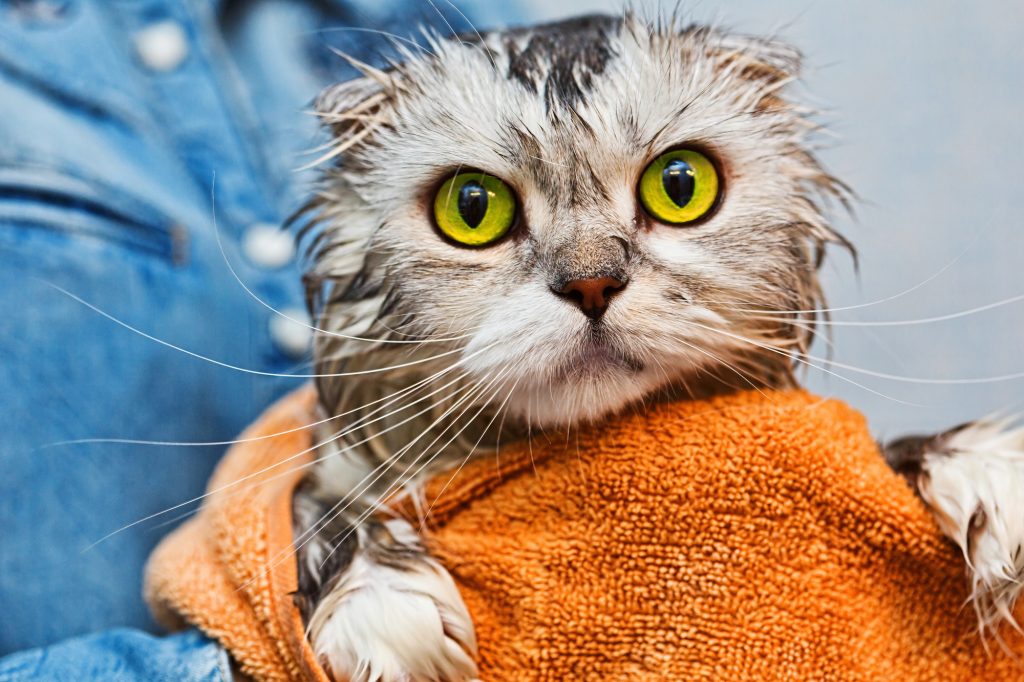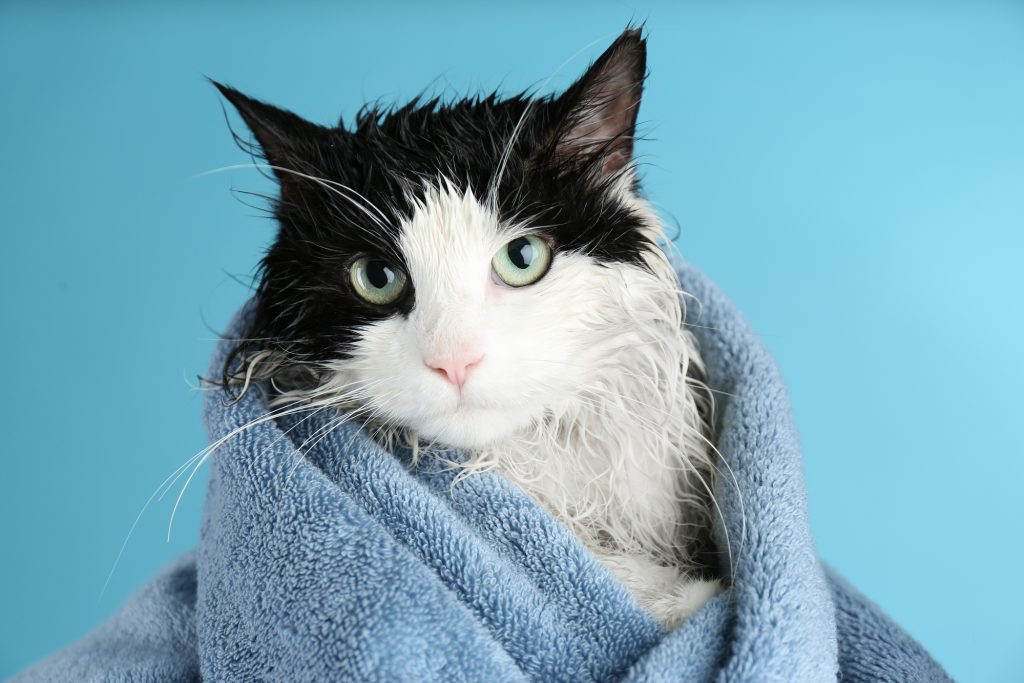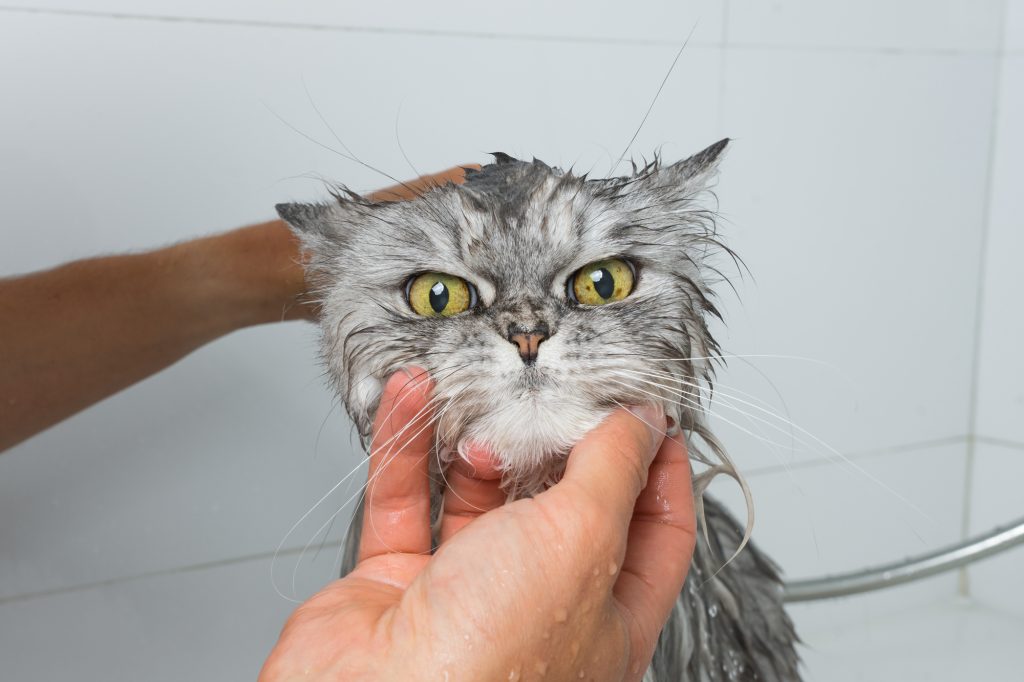Table of Contents
Cleaning a cat may seem daunting, but with patience and the right approach, it can be a bonding experience for you and your pet. Cats are generally self-grooming, but there are times when a little extra help is needed to keep them clean and healthy. Whether it’s due to getting into something sticky or needing help with their grooming routine, washing a cat can be done safely at home with minimal stress for both of you.
Ensuring your cat’s comfort and safety during the cleaning process is key. Preparing in advance, moving gradually, and using products specifically designed for cats will make the experience pleasant. It’s important to remember that not all cats will enjoy a bath, so always respect your pet’s limits and look for signs of stress.
Preparing for a Cat Cleaning Session
Before you begin the task of washing your furry friend, it’s important to get everything ready. By having all the necessary items at hand, you’ll create a smooth and efficient cleaning session that minimizes stress for your cat and ensures a quicker bathing process.
Gather the Necessary Supplies
Successful cat grooming starts with the right tools. Prepare specialized cat shampoo or gentle soap that won’t irritate your cat’s skin, soft towels for drying, a brush or comb for detangling, and grooming wipes for quick cleanups. Remember to keep treats ready for positive reinforcement.
• Specialized Cat Shampoo or Gentle Soap
Choosing the right cleaning agent is crucial when washing a cat. Look for specialized cat shampoo that’s formulated to be gentle on their skin and coat. Human shampoos and soaps can be harsh and may cause irritation or remove essential oils from their fur. A mild, cat-specific product will clean effectively without causing discomfort.
• Soft Towels
Soft towels are an essential part of the cat cleaning kit. After a bath, your cat will appreciate being wrapped in a warm, cozy towel that absorbs water quickly. Having several towels on hand is helpful, as you may need to switch to dry ones during the drying process to ensure your cat stays warm and comfortable.
• Brush or Comb
Regular brushing your cat not only prevents matting but also distributes natural oils for a healthy skin and coat. For short-haired cats, a fine-toothed comb or soft-bristled brush works best. Adult cats with longer fur may require a wide-toothed comb or a specialized brush. Regular grooming can prevent fleas and ticks and reduce the likelihood of ear problems by removing excess hair around the ears.
• Cotton Balls or Q-Tips
While washing your cat, you’ll want to avoid getting water in their ears, which can lead to infections. Cotton balls or Q-tips can be helpful to gently clean the outer ear area without causing any harm. Be careful never to insert anything into the ear canal, as this could cause serious ear problems.
• Treats and Positive Reinforcement
Positive reinforcement goes a long way in making bath time a positive experience for your cat. Having a stash of their favorite treats to reward them for their patience and cooperation can help create positive associations with grooming. Offer praise and treats generously to reinforce calm behavior during and after the cleaning process.
Acclimate the Cat to the Process
Getting your cat comfortable with grooming sessions is crucial. Start by letting your cat explore the grooming tools. Allow her to sniff the brush, grooming glove, and towels to establish a sense of familiarity. During this phase, reward your cat with treats and affection to build positive associations with the grooming items.
Before attempting to bathe a cat, spend several days or even weeks getting her used to the idea. Place her in an empty bathtub, using treats and gentle strokes to make her feel at ease. Regular brushing can also help your cat become accustomed to being handled and will make the actual cleaning process smoother when the time comes.

The Cat Cleaning Process
Cleaning your cat involves a series of steps designed to ensure her comfort and hygiene without causing undue stress.
1. Introducing the Cat to Water
When it’s time to give your cat a bath, introduce her to water gradually. Start with just an inch of warm water, letting her get her paws wet without overwhelming her. Cats need baths infrequently, but when they do, it’s important that the cat is comfortable with each step. Use a gentle spray or cup to pour water over her body, avoiding her head.
During the process, speak softly and reassure your cat. If she becomes agitated, take a break and try again later. The goal is to cleanse her skin and fur without causing anxiety. Using a damp cloth can help ease her into the sensation of being wet before moving on to more water.
2. Applying the Shampoo or Soap
Once your cat is wet, apply a specialized cat shampoo or gentle soap. Human shampoo should never be used as it can disrupt the pH balance of your cat’s coat and skin. Lather the shampoo carefully, avoiding the eyes and ears. The soap removes dirt and excess oil, leaving the cat’s coat shiny and clean.
Be sure to work the shampoo into the fur to reach the skin where oils and dirt can accumulate. This step in the bathing your cat process is not just about aesthetics; it’s also about maintaining her health by preventing potential skin issues.
3. Rinsing the Cat Thoroughly
After shampooing, rinse your cat thoroughly to avoid leaving any shampoo residue, which can irritate the skin if not completely washed away. Use a gentle stream of lukewarm water or a wet cloth to carefully remove all traces of soap from her fur. It’s important to be thorough but also quick to minimize stress.
Ensure that the water runs clear before you finish the rinsing stage. Pay particular attention to areas where shampoo might hide, such as under the legs or the belly. A final check over her body will help ensure that your cat’s coat is free from any soap remnants.
4. Drying the Cat
Once the bath is done, wrap your cat in a soft towel and gently pat her fur to remove excess water. The drying process should be as stress-free as possible, and using a warm towel can help your cat relax. Some cats may tolerate a hair dryer on the lowest heat setting, but always be cautious and observe how your cat reacts.

Cleaning Specific Areas
Cleaning a cat also involves special attention to her face, ears, paws, nails, and anal area, ensuring her complete hygiene.
• Face and Ears
To clean your cat’s face and ears, use a damp cloth to gently wipe around the eyes, nose, and mouth. Be careful not to get water inside her ears. Check for signs of ear infection, such as redness or a bad smell, and use a cotton ball or Q-tip to clean your cat’s ears, but never insert it into the ear canal.
If your cat shows signs of ear discomfort or discharge, consult a vet. Regular grooming can prevent the buildup of earwax and debris, which can lead to health issues. Keep the sessions short and reward your cat with treats to make the experience positive.
• Paws and Nails
Examine and clean your cat’s paws by gently wiping them with a damp cloth. This is also an opportunity to check between her toes for any signs of injury or household chemicals that she might have stepped in. Regularly trim your cat’s claws to prevent overgrowth and issues with walking or scratching.
After wiping her paws, use a specialized nail trimmer to carefully clip the tips of her claws. If you’re uncertain about how to safely trim your cat’s claws, seek guidance from a vet or professional groomer. It’s important that the cat is comfortable during this process to avoid stress or injury.
• Anal Area
Keeping the anal area clean is an essential part of feline hygiene. Use a damp cloth to gently wipe around your cat’s back end, ensuring any remnants of feces are removed. This is particularly important for long-haired breeds that may have issues with waste sticking to their fur.
If you notice any signs of irritation or infection, such as redness or swelling, it’s important to take your cat to the vet. Keeping this area clean can prevent discomfort and health issues related to hygiene. Be gentle and quick to minimize your cat’s stress during cleaning.
Maintaining Overall Hygiene
Regular cat grooming is vital for maintaining your pet’s health and includes brushing, nail trims, and ear cleaning.
Brushing and Grooming
Brushing your cat’s fur not only keeps her looking good but also helps prevent matted fur and reduces the likelihood that your cat is suffering from hairballs. Use a brush suited to your cat’s coat type and brush her regularly to remove loose hair and distribute natural oils.
Nail Trimming
Regular nail trims are important to keep your cat’s claws at a healthy length. Trim the tips carefully, avoiding the quick, which if cut can cause pain and bleeding. If you’re unsure about how to trim the nails, seek guidance from your vet.
Cleaning the Cat’s Environment
Keep your cat’s living area clean to help prevent health issues. Wash bedding frequently, clean and disinfect the litter box, and watch for signs of fleas, ticks, or ear mites. Regularly check your cat for bald spots, flea dirt, or watery eyes as these can indicate health problems.
Special Circumstances Requiring Extra Care
Elderly or Disabled Cats
When cleaning elderly or disabled cats, pet owners should consider their pet’s limitations. These cats may not tolerate regular baths well, so limiting the frequency is important. Washing such a cat requires a gentle approach, using a damp cloth for spot cleaning, rather than subjecting the cat to the stress of full immersion in water. It’s vital to ensure the cat is comfortable and supported throughout the cleaning process, and to always keep the sessions brief to minimize strain on the cat’s body.
Cats With Medical Conditions
For cats with medical conditions, hygiene is crucial, but regular baths may not always be advisable. Consulting with a veterinarian is key to determining the best cleaning regimen for these pets. A vet might suggest specific cleaning products or techniques that are safe for the cat’s condition. It’s important to gently cleanse any soiled areas and to regularly check for signs of discomfort or infection that might warrant medical attention or an alternative approach to cleaning.

Frequently Asked Questions
1. How often should I bathe my cat?
Most cats don’t require regular baths, especially if they are short-haired. However, long-haired cats may benefit from occasional washing to prevent matting. When washing a cat, it’s important to brush your kitty’s coat beforehand to remove loose fur and to trim your cat’s nails to prevent scratches. A bath every few months is usually sufficient unless advised otherwise by a vet.
2. What type of shampoo or soap is best for cats?
Choosing the right shampoo or soap for your cat is essential to maintain healthy skin and fur. Cats have sensitive skin, so look for cat-specific shampoos that are free of harsh chemicals and fragrances. Hypoallergenic or oatmeal-based products can be especially soothing. Always avoid human shampoos, as they can disrupt the pH balance of your cat’s skin and cause irritation.
3. How can I make the cleaning process less stressful for my cat?
To reduce stress during cleaning, start by acclimating your cat to the supplies and space. Use a calm and reassuring tone while gently introducing your cat to water. For indoor cats, a familiar environment can help, so consider using the sink or a small tub where they feel secure. To prevent skin irritation, thoroughly rinse any cleaning products from your cat’s fur.
Summing up the Suds
Cleaning your feline friend is much more than just a splash in the tub—it’s an important part of their health and wellness routine. Regular grooming habits not only keep your cat looking dapper but also provide an opportunity to examine your cat’s skin for any irregularities such as dried blood or signs of ear infections. Paying close attention to these details can help prevent health problems down the line and ensure that your cat is as comfortable and happy as possible.
While most cats are proficient self-groomers, there are times when a professional groomer may be necessary, especially if your cat has long hair or is unable to clean themselves properly due to age or disability. Remember to be gentle when cleaning around sensitive areas like the cat’s neck and always use positive reinforcement with treats to make the experience enjoyable. With patience and care, your cat will look and feel purr-fect!

Hi, I’m Zoey, a devoted mom to two charming Siamese cats. My passion lies in assisting fellow pet owners in providing optimal care for their cats. On CatsEuphoria, I share practical tips and relatable stories, inviting you to join me in appreciating the authentic bond between humans and our beloved feline companions.




